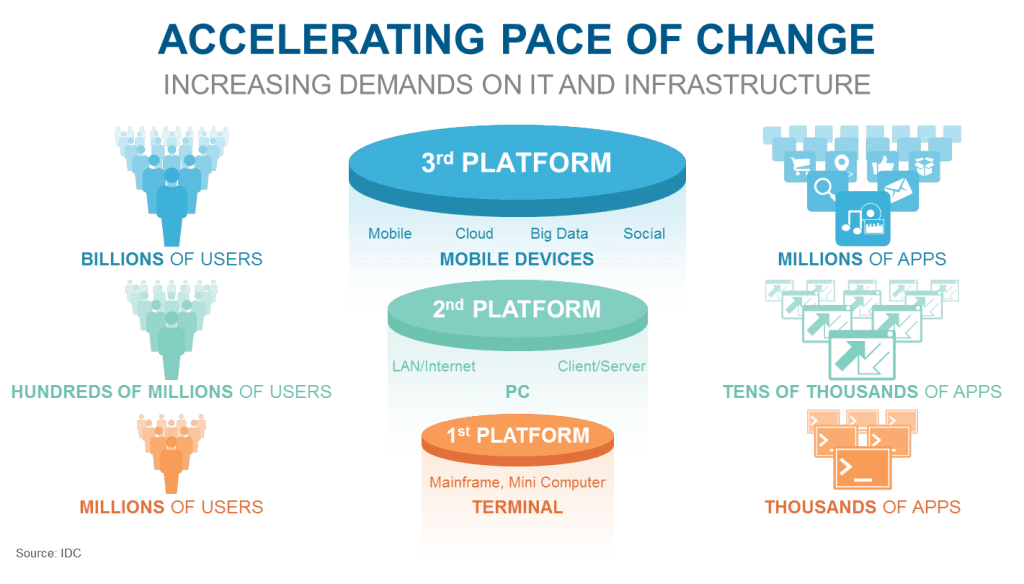Over the years ahead, digital transformation will form the base for innovation and growth, sending shockwaves through the competitive landscape in all sectors. What is digital transformation all about? What will the fundamentals of IT be for the coming years? In this blogpost we explain what it’s about and why waiting is not an option.
The fundamentals of digital transformation: the ‘third platform’
The cornerstone of digital transformation is known as the ‘third platform’. After the mainframe (first platform) and the client-server model (second platform), the third platform features interplay between cloud computing, mobile computing, social media and big data and analytics. Combining the strengths of these four main pillars will provide a springboard for growth in IT and innovation in the years ahead.
The cloud has now made a real breakthrough, including in Belgium, and offers companies enormous additional strength, flexibility and efficiency, because it enables them to buy software and hardware as a service instead of investing their own capital. Big data and the analysis of old and new data offer unprecedented insights that help with strategic decision-making. Mobile computing has changed the way in which companies and their staff work together and communicate for good. Just like using social media makes it possible to gain marketing insights and forging a bond with customer and employees in a new way.
Strategic impact for believers and non-believers
Digital transformation is not a passing trend. In various companies from a whole range of sectors it has now become a fundamental part of strategy. Thanks to digital transformation, they are able to develop products more quickly and bring them to market. Or work more efficiently, improve and speed up processes or cut costs. Today, challenges that were previously too complex to resolve or targets that simply couldn’t be achieved, are no longer ‘impossible’. Digital transformation gives the companies that embrace it a lead that they need never relinquish.
At the same time, too many companies, for various reasons, are still afraid of what they see as a digital tidal wave, or… a storm in a teacup. They are (still) unable to make a link between technology and the benefits it can bring to their business. A recent survey shows that 80 per cent of Belgian decision-makers in IT are currently forced to spend more time maintaining their current IT systems, instead of looking for new solutions. For those companies that bury their heads in the sand about digital transformation, it is only a question of time before smart(er) ‘digital’ competitors really begin to make their business hurt. Good examples of this are Uber and Airbnb.
Not pie in the sky
This ‘third platform’ will create a range of new possibilities and opportunities. New technological applications make new, innovative business models, products and services possible. This will be vital for some companies to survive. The most important innovations will be driven by new forms of IT security, augmented and virtual reality, the Internet of Things, cognitive systems, robotics and 3D-printing. (see IDC diagram)
Over the coming years, investments in the second platform (the client-server model) will decrease significantly and make room for investments in the third platform and in new technologies. And although many of these technological advances still sound like pie in the sky, they will be part of our everyday lives – both at home and at work – sooner than we think.
How to get digital transformation started
Digital transformation is well on the way and it is high time that Belgian companies jumped on board. “How do we get started?” is a question we are asked frequently. Here is the answer: begin by answering this question: “Can we make better use of technology to enable us to reach our business goals faster and to push back our boundaries?”. Take advice from a dependable partner who will examine your current situation and needs and sit down with you to work out how your company can get on track for the future.
Diagram: how the third platform and new technological applications together create digital transformation (source: IDC)
